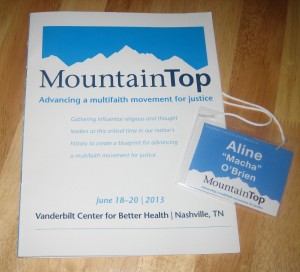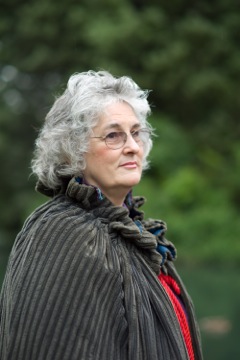On June 17, 2013, religious leaders from around the country met in Nashville, Tennessee at the very first MountainTop Summit. Held at the Vanderbilt Center for Better Health, the three-day event “uniquely focused on exploring the shape and priorities of this nation’s multifaith movement for justice in the 21st century.” MountainTop was founded and presented by Vanderbilt University’s Divinity School, Auburn Theological Seminary in New York City, Imaginal Labs and Synthesis Corps. In a press release, they explain:
“In sessions designed to discuss organizing, collaboration and new media, among other topics, the summit [equipped] leaders with the tools, methodologies, and relationships to inform their work on a range of issues — from immigration to marriage equality.”
MountainTop was attended by over 80 participants who are “working in the sectors of education, media, research, community organizing, arts, and culture [and] whose work is rooted in their faith and values.”
In attendance at this unique and progressive event was Aline “Macha” O’Brien known to many as M. Macha Nightmare. In February, she was invited to attend the event by way of friends and her association with Auburn Theological Seminary. Macha said, “anything that would foster collaborative efforts towards social, economic and environmental justice among different religions was something I’d like to participate in.” So on June 17th, she packed up her bags and headed for Nashville.
I had the pleasure and the opportunity to speak with Macha about her experience at MountainTop. Our discussions will be posted in two parts over two Sundays. First, Macha answers general questions about the event itself. In part two, we’ll discuss the content and the meaning behind its title “multifaith movement for justice.”

Part I: The MountainTop Summit
Heather: How was MountainTop different or the same as other multifaith events?
Macha: I’d say it had a more intense focus on working together to identify and implement collaborative projects. However that might manifest in this particular assemblage more than most interfaith or multifaith efforts I’ve experienced. Most of my experience working with those of other religions, regardless of what it’s called, has been local and regional rather than national. MountainTop included people from various parts of the country.
H: Was there a specific goal, aim or theme for the event?
M: Goals were not specific. The process, the people, and their creativity determined the specific goals. We were asked to reflect upon three questions in preparation for our time together:
- What are the capabilities and aspirations that your organization, or you personally, bring to the multifaith movement for social justice?
- What is your theory of change?
- What are the challenges that we face?
As a representative of a religion(s) with a smaller demographic and specifically as a representative of CoG [Covenant of the Goddess], an organization that has far more grass roots than the institutions of mainstream religions, I felt that whatever I might bring to this effort would be more spice than stock.
 H: How many Pagans participated in total?
H: How many Pagans participated in total?
M: Four, all women, three arising from the same “matrix,” if you will, of Reclaiming Craft.
H: What was the reaction to your inclusion? Did participants already have experience interacting with those in Pagan or Heathen religions?
M: We were accepted. I didn’t notice any particular reaction. I think some were more or less familiar with Wiccans, if not other forms of Paganism. For others meeting a Pagan was a brand new experience. Everyone took care in how we interacted. We weren’t tiptoeing, but we were sensitive and respectful.
Actually, I think that some of the more conventional people there might have been a wee bit put off by meeting someone from a religion so different from what they know. In any case, I experienced the overall spirit of the gathering as one of goodwill and commitment to service for the commonwealth.
H: What other religions were represented?
M: In addition to people from faith-based justice projects, there were others not specifically identified with a faith, such as media and leadership consultants, philanthropists and people from the financial community, and immigrant rights and day laborer activists.
As you might expect, religious professionals were mainly Abrahamic (Islam, Judaism, and Protestant Christianity) and Sikh. Perhaps there were other [religions represented] that I didn’t identify as being different. In three days’ time of focused work, we didn’t get the opportunity to meet and become better acquainted with every single other person there.
[While] there were two people who were Catholic-reared, I was surprised there was no one [representing] any Roman Catholic organization. In my experience sisters and priests are often among the most committed to justice efforts. In my own home interfaith council, I cherish my friends among the Dominican Sisters of San Rafael and appreciate their unwavering support of social justice concerns.
The other religious persuasion noticeably absent was Buddhism. Again, in my local work I collaborate with people from several different Buddhist sects. They work on issues of food and nutrition for the hungry, teens, worker justice, peace, and the like. [In addition] no Hindus participated. Hinduism doesn’t represent a huge demographic, but in my experience they are strong activists and allies to Pagans.
I know that many more people were invited than were able to attend. When I mention what to me are glaring omissions, I am not criticizing the organizers. I was not privy to that process and am confident that they intended to be as inclusive as possible.

Vanderbilt Center for Better Health at Vanderbilt University Health Center
Interview to be continued….
You can read more about the specifics of how the conference was organized and structured on Macha’s own blog or on Patheos’ Pagan Channel’s new blog Wild Garden. In that article Macha emphasizes MountainTop’s focus on new and innovative technology. She talks about the implementation of the DesignShop process and its three phases which include: Scan, Focus, and Act. She also mentions that one of “the strongest and most helpful phrases used [during one specific workshop] was “collaborative intelligence,” a form of understanding that arises from the interactivity that digital communication fosters.”
Next week I will post the second part of this interview that examines MountainTop’s focus on social justice. Macha will also share the event’s personal impact as she continues to process an experience that was packed with spiritual and social significance.
The Wild Hunt is not responsible for links to external content.
To join a conversation on this post:
Visit our The Wild Hunt subreddit! Point your favorite browser to https://www.reddit.com/r/The_Wild_Hunt_News/, then click “JOIN”. Make sure to click the bell, too, to be notified of new articles posted to our subreddit.
Good to see Pagan representation on a national interfaith summit.
It has to be difficult, though, when the other attendees are official representatives of their religion, whilst the perception will be that the Pagans represented only a relatively small number of their own ‘religion’.
I’m not sure I understand your comment, but if I do understand it, I don’t see any special difficulty. When a rabbi attends an interfaith conference, people understand that he or she represents a Jewish point of view, not the Jewish point of view. A Modern Orthodox rabbi and a rabbi from the Jewish Renewal movement represent different, relatively small groups of Jews and will have points of agreement and disagreement. Same thing with any Protestant minister, imam, or medicine woman.
Aline O’Brien is an official interfaith representative of the Covenant of the Goddess and has formal authority to speak for CoG at events of this kind. CoG’s national interfaith representatives apply and annually reapply for the position on the basis of their continuing work and service; their applications are approved (or not) by the Covenant’s national board, which is democratically elected by the membership. So if the question is, “Who gives Aline the right to speak for witches?” the answer is, “The members of the Covenant of the Goddess, all of whom are witches, and all of whom are recognized as witches by other witches.”
Since CoG includes member covens and solitaries from the larger Craft traditions in the U.S. and many smaller ones, and has chapters and member covens in more than half of the United States, CoG’s interfaith reps have as good a basis to speak on behalf of American witches as any individual Witch can in a decentralized religion.
I would think that if the Pagan Federation in Great Britain has official interfaith representatives, they would have similar qualifications to speak on behalf of Pagans in the UK. Obviously no individual can fully represent the diverse viewpoints of all pagans, but a well established, respected and diverse organization like the Pagan Federation ought to have the same standing in interfaith work as comparable bodies of other religions.
I am not criticising Aline, or any of the others. I am making an observation about organisational bias.
As for the PF… the Catholic Church refuses to engage in interfaith with them.
When a Catholic or Anglican priest goes to an interfaith conference, they go as a representative of their religious organisation.
Usually, an interfaith conference will have representatives from both Catholic and Anglican communions. Paganism, being that much more diverse, would be much harder to represent in such a fashion, would it not?
Thanks for observations and comments.
Although I do have official sanction to speak in interfaith contexts on behalf of CoG, I still find this somewhat restrictive since the membership, even tho it’s all Witches, is diverse. We don’t all agree on many political issues, ones I would think one’s Witchen perspective would find to be a no-brainer. Such is not the case.
Beyond that, though, I feel that when I have a seat at the inter/multifaith/inter-religious table I speak for Pagandom in general. I suspect there are many Pagans who wouldn’t like that. Regardless, the mainstream population views us as kinda edgy and strange and if they know anything at all, they think most Pagans are Wiccans. (I am not.) People of other religions do not look under every Pagan rock to see who has a bonafide Gardnerian lineage, who’s a bootstrap eclectic, who’s a Druid and who’s Hellenismos or Norse in focus or Kemetic. So I feel that the conduct of those of us who do work in the interfaith arena reflects upon all Pagans.
I will say this, though, and that is that people in interfaith work treat each other with kindness and respect, which is not always the case amongst Pagans — or probably amongst mainstream denominations internally, all parties being of the human persuasion.